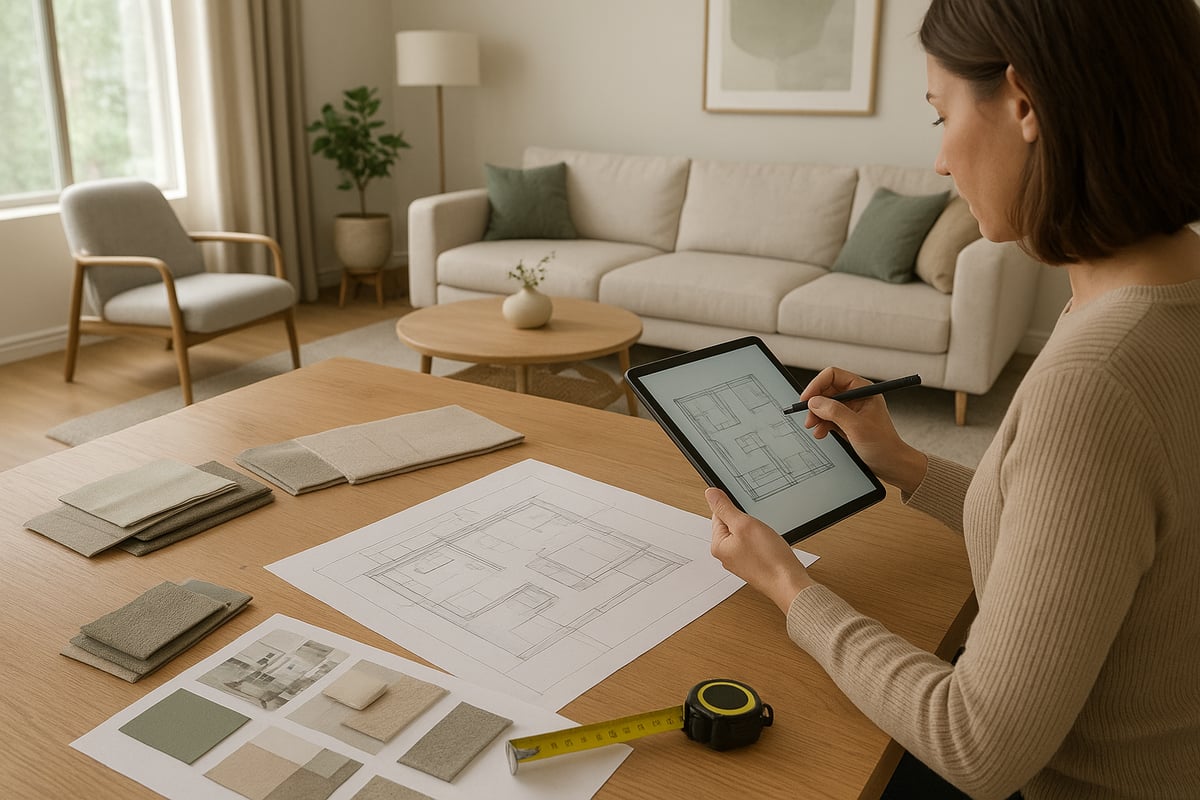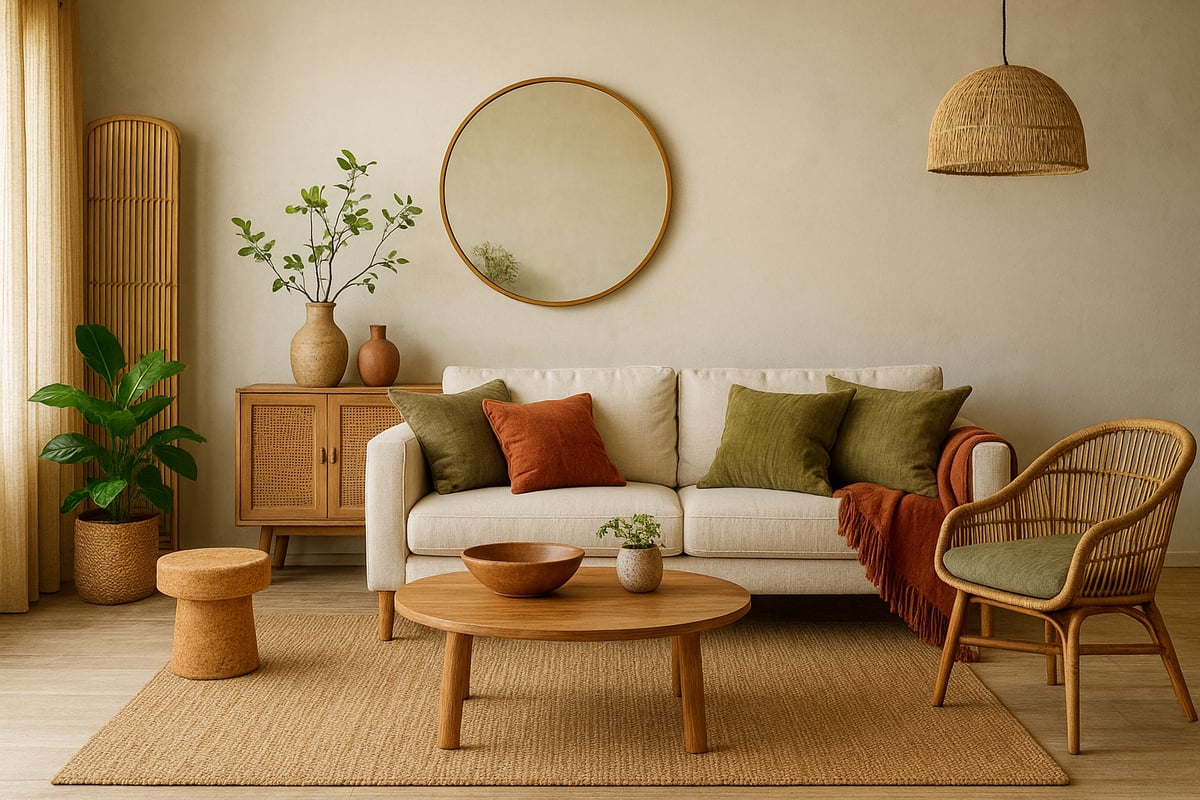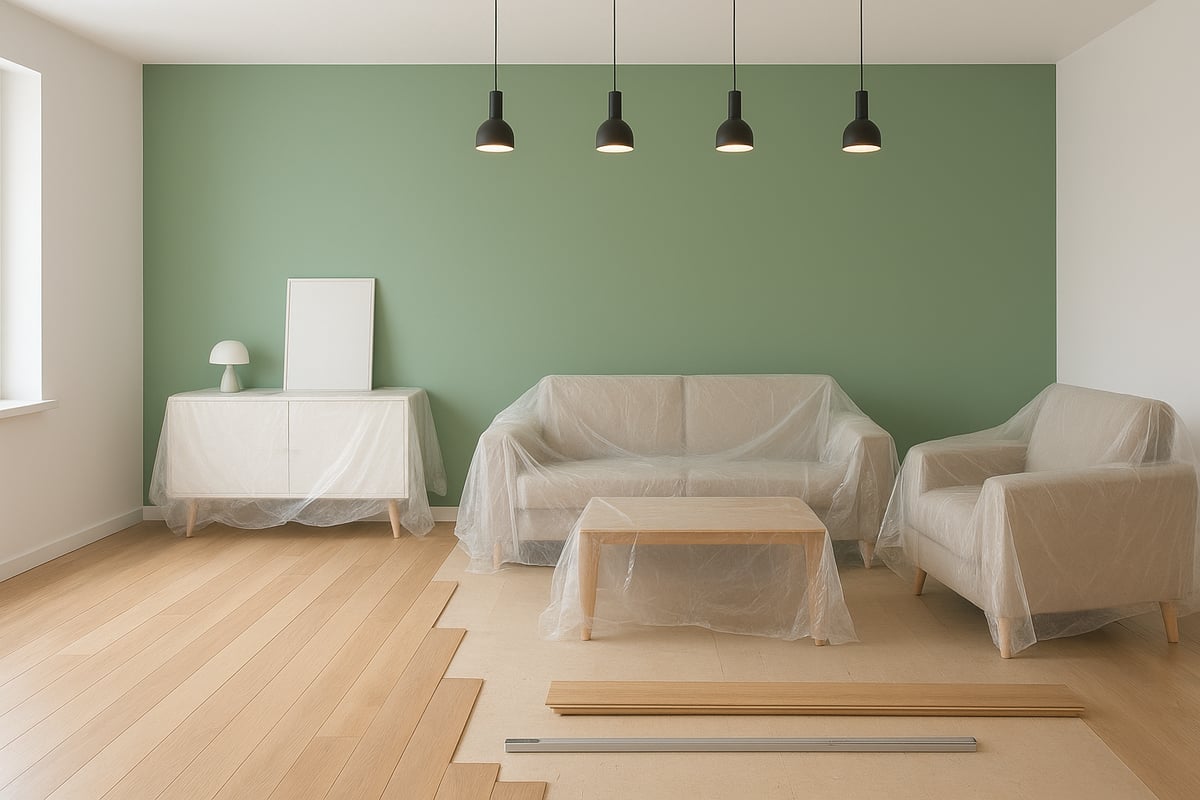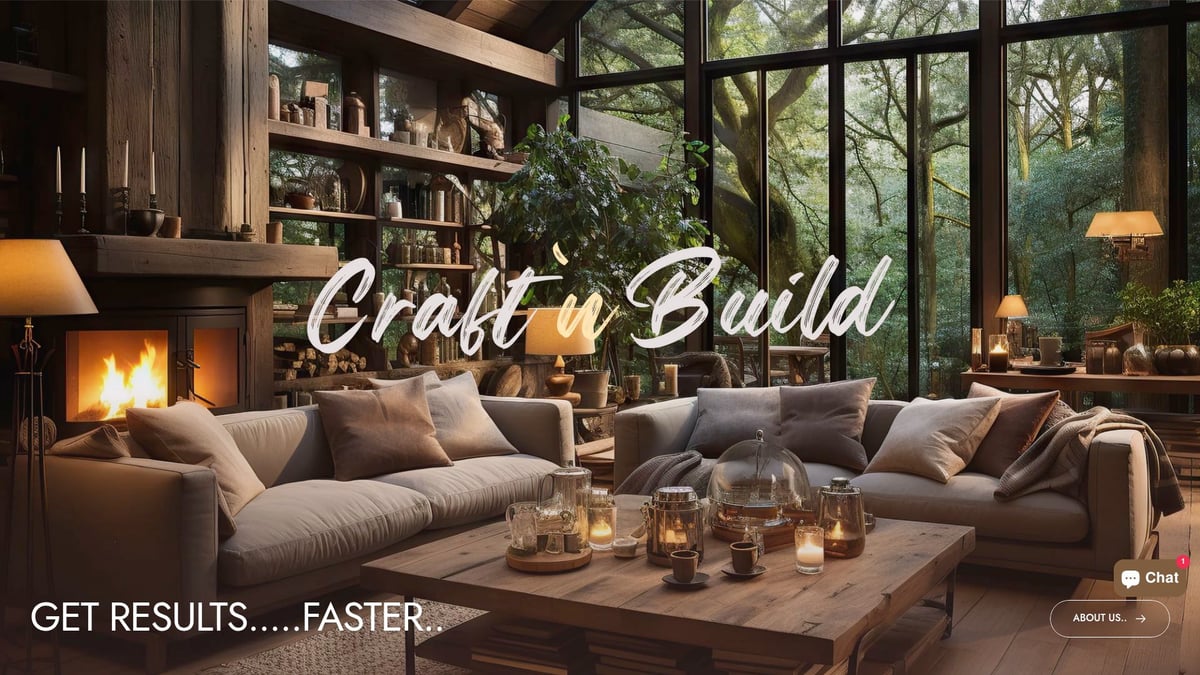Imagine stepping into a space that feels entirely new, where every detail reflects your vision and the latest innovations in interior decoration work. As we look toward 2025, the way we design our homes and offices is evolving rapidly, offering more possibilities than ever before.
This guide is designed to walk you through each stage of interior decoration work, making it accessible for anyone eager to transform their environment. From planning and choosing the right styles and materials, to executing projects and integrating cutting-edge technology, you’ll learn how to achieve remarkable results.
We will explore the latest trends, tackle common challenges, and offer practical steps you can implement. Ready to unlock the full potential of your space? Let’s begin your journey to a more inspired interior.
Step 1: Planning Your Interior Decoration Project
Transforming your environment begins with a solid plan. Before starting any interior decoration work, careful preparation ensures the project meets your goals, stays within budget, and delivers a cohesive result. Whether you are updating a single room or reimagining your entire home, a methodical approach sets the stage for success.

Understanding Your Space and Needs
Begin by evaluating each room’s function, size, and natural lighting. This assessment is foundational for all interior decoration work, as it clarifies what changes will have the most impact. Identify pain points such as:
- Excessive clutter
- Insufficient or harsh lighting
- Lack of design cohesion
- Outdated fixtures or finishes
Set clear objectives for your interior decoration work. Your goals might include:
- Enhanced visual appeal
- Improved functionality
- Increased property value
For example, an open-plan living room requires a different planning strategy than a compact studio. Open spaces may need defined zones for lounging, dining, and work, while a studio demands smart storage and multi-use furniture. By understanding your space, you create a roadmap that addresses both current challenges and future needs.
Budgeting and Timeline
A well-defined budget is essential for any interior decoration work. Start by calculating all potential expenses, including materials, labor, and a contingency fund for unexpected costs. Prioritize high-impact areas such as the living room or kitchen, as updates here often yield the greatest return.
Consider these budgeting tips:
- Allocate 20% of your budget for unforeseen expenses.
- Invest in quality materials for longevity.
- Track all purchases to avoid overspending.
Create a timeline for each phase of your project. Set milestones for design, purchasing, and installation. According to Houzz, 46% of homeowners exceed their initial renovation budget, underscoring the importance of realistic planning. By mapping out your timeline, you help prevent delays and manage expectations throughout your interior decoration work.
Gathering Inspiration and Setting a Vision
Curating inspiration fuels the creative process. Utilize mood boards, digital visualization tools, and design platforms to refine your vision. Consider the latest trends in sustainability and wellness for 2025, such as biophilic design and eco-friendly materials.
Popular sources of inspiration include:
- Pinterest boards for color schemes
- Instagram accounts for trending styles
- Online galleries for material ideas
For those new to interior decoration work, resources like the Beginner's Home Interior Guide offer step-by-step advice on gathering ideas and defining your aesthetic. This foundation helps translate inspiration into actionable plans for your space.
Consulting Professionals vs. DIY
Deciding between hiring professionals and taking a DIY approach is a key step in interior decoration work. Weigh the benefits of professional expertise, such as access to specialized design knowledge and project management. However, DIY can offer cost savings and greater creative control.
When to consult experts:
- Structural changes (e.g., removing walls)
- Complex installations (e.g., custom cabinetry)
- Projects involving plumbing or electrical work
According to HomeAdvisor, 38% of homeowners regret not seeking professional help during their projects. Understanding when to involve architects, designers, or contractors helps mitigate costly mistakes and ensures your interior decoration work is both efficient and safe.
Step 2: Choosing Styles, Colors, and Materials
Selecting the right styles, colors, and materials is the heart of any successful interior decoration work. These choices determine how your space feels, functions, and stands the test of time. In 2025, fresh inspiration and practical considerations combine to help you create a home or office that truly reflects your personality and values.

Identifying Your Preferred Design Style
The first step in interior decoration work is defining your design style. In 2025, popular styles include minimalism, Japandi, maximalism, and vintage revival. Each offers a distinct mood and approach.
- Minimalism: Focuses on simplicity, clean lines, and uncluttered spaces.
- Japandi: Blends Japanese and Scandinavian aesthetics for warmth, calm, and natural materials.
- Maximalism: Embraces bold colors, layered patterns, and curated collections.
- Vintage Revival: Reimagines classic elements with a modern twist.
Blending styles is trending, but balance is key. For example, you might pair Scandinavian simplicity with a statement maximalist rug or bold art. To explore more about trending looks, check out the Essential Interior Design Styles 2025 guide.
| Style | Key Features | Best For |
|---|---|---|
| Minimalism | Clean, airy, functional | Small or busy spaces |
| Japandi | Calm, natural, cozy | Living rooms, bedrooms |
| Maximalism | Vibrant, expressive | Creative studios |
| Vintage | Nostalgic, timeless | Dining rooms, offices |
Selecting a Color Palette
Color is a powerful tool in interior decoration work, influencing both mood and perception. Understanding color psychology helps you set the right atmosphere. For example, earthy greens promote calm and wellness, while bold statement colors energize a room.
Trending palettes for 2025 include:
- Earthy greens: Symbolize renewal and serenity.
- Warm neutrals: Create a welcoming, timeless base.
- Bold accents: Add personality and modern flair.
According to color forecasts from Pantone and Sherwin-Williams, we will see more nature-inspired hues and confident, saturated tones. When planning your palette, use a digital color wheel or mood board to visualize combinations before committing.
Material Selection for Longevity and Sustainability
Choosing the right materials elevates both the appearance and durability of your interior decoration work. Natural materials like wood and stone bring warmth and authenticity, while engineered options such as high-quality laminates or composites offer resilience with less maintenance.
Sustainability is a top priority in 2025. Consider:
- Bamboo: Rapidly renewable and versatile.
- Recycled glass: Adds visual interest and reduces waste.
- Low-VOC paints: Improve air quality and health.
- Cork flooring: Durable, eco-friendly, and comfortable underfoot.
| Material | Pros | Cons |
|---|---|---|
| Wood | Warm, timeless, natural | Needs upkeep |
| Engineered | Durable, cost-effective | Can lack authenticity |
| Bamboo | Fast-growing, sustainable | Less variety in finish |
| Cork | Soft, eco-friendly | Sensitive to moisture |
Finishes and Textures
The final layer of interior decoration work involves finishes and textures. Layering different textures—think linen curtains, velvet cushions, or sisal rugs—adds depth and visual interest. Matte finishes are ideal for walls and ceilings, creating a soft, modern look, while gloss finishes can highlight cabinets or accent pieces.
Textured walls are a standout trend for 2025. Limewash and decorative plaster offer tactile appeal and subtle color variations, making spaces feel both current and timeless. Experiment with a mix of matte and gloss in the same room for a curated, designer feel.
Every detail in your choices, from style to finish, contributes to the overall success of your interior decoration work. With thoughtful planning, you can achieve a space that is both on-trend and uniquely yours.
Step 3: Executing Interior Decoration Work
Embarking on the execution phase of your interior decoration work is where vision meets reality. This stage transforms plans into tangible improvements, shaping every detail of your living or working environment. By following a structured approach, you can ensure each step is efficient, cohesive, and rewarding.

Preparing the Space
Preparation is the foundation of successful interior decoration work. Start by removing clutter and deep cleaning the area to create a blank canvas. This step ensures that dust, dirt, and unnecessary items do not interfere with the transformation.
Next, protect existing floors, furniture, and fixtures. Use dust barriers, painter's tape, and drop cloths to shield surfaces from paint splatters and debris. Covering air vents and sealing off adjacent rooms minimizes dust spread and keeps the workspace organized.
By investing time in prep, you avoid costly mistakes and set the stage for smooth, efficient progress. A well-prepared space also creates a safer environment for everyone involved in the interior decoration work.
Painting and Wall Treatments
Painting is one of the most impactful aspects of interior decoration work. Begin by patching holes, sanding surfaces, and applying a quality primer. Select paint finishes that match your room’s function—matte for living spaces, semi-gloss for kitchens and baths.
Beyond paint, explore wall treatments such as wallpaper, decorative plaster, or textured panels. Feature walls remain popular; in fact, 52% of homeowners in 2024 opted for accent walls. For a detailed, stepwise process, refer to this Step-by-Step Interior Design Guide.
Careful wall preparation and finish selection help your interior decoration work stand the test of time while reflecting personal style.
Flooring Installation and Upgrades
Flooring choices set the tone for every space. Hardwood, laminate, and tile remain timeless, while eco-friendly options like cork and bamboo are gaining ground in interior decoration work. Each material offers unique benefits for durability, maintenance, and aesthetics.
Before installation, allow materials to acclimate to room conditions. Lay underlayment to reduce noise and moisture. For added comfort, consider heated flooring systems which boost both efficiency and luxury.
Proper installation techniques ensure longevity and maximize your investment. With thoughtful choices, flooring becomes a key element of cohesive interior decoration work.
Lighting Design and Installation
Lighting is essential for both function and atmosphere in interior decoration work. Implement layered lighting by combining ambient, task, and accent sources. This approach creates depth and flexibility for every activity.
Upgrade to energy-efficient fixtures, especially LEDs, which can cut energy costs by up to 75%. Integrating smart lighting controls allows for scheduling, dimming, and even color changes at your fingertips.
Compare lighting types:
| Type | Use Case | Benefit |
|---|---|---|
| Ambient | General lighting | Even illumination |
| Task | Work areas | Focused brightness |
| Accent | Art, features | Highlights focal points |
Strategic lighting choices elevate the impact of your interior decoration work while supporting comfort and efficiency.
Furniture Arrangement and Selection
Careful furniture arrangement is vital in interior decoration work. Start by identifying focal points, such as a fireplace or a large window. Arrange pieces to create natural flow and encourage conversation.
Mix pre-made and custom furniture for a personalized look. Modular sofas and multipurpose pieces, like storage ottomans, offer flexibility for changing needs. In compact spaces, opt for furniture that serves multiple purposes without crowding the room.
A balanced layout makes your interior decoration work feel intentional, inviting, and adaptable to evolving lifestyles.
Accessorizing for Impact
Accessories are the finishing touches that bring interior decoration work to life. Select rugs, artwork, and decorative objects that reinforce your color scheme and design style. Plants introduce freshness and support wellness trends.
When arranging accessories, follow the rule of thirds and group items in odd numbers for visual harmony. Large-scale art pieces are highly recommended, with 68% of designers favoring them for modern interiors.
Thoughtful accessorizing ensures your interior decoration work feels complete, cohesive, and uniquely yours.
Step 4: Integrating Smart Technology and Modern Features
The landscape of interior decoration work is rapidly evolving in 2025. Technology and innovative features are now essential for creating spaces that are not only beautiful but also functional and future-ready. Whether you are updating a single room or transforming your entire home, integrating smart solutions into your interior decoration work will ensure your space stands out and supports modern living.
Smart Home Essentials
Smart home devices are reshaping how we interact with our environments. For effective interior decoration work, start by considering smart thermostats, automated lighting systems, and advanced security solutions. These technologies do more than add convenience—they enhance energy efficiency and provide peace of mind.
Imagine adjusting your lighting or climate with a simple voice command. Voice-activated assistants, such as those from leading tech brands, are now central to interior decoration work, enabling seamless control of connected devices. The rise of integrated technology is one of the defining trends for 2025, as highlighted in the 2025 Interior Design Forecast: AD PRO's Predictions for the Whole Home. By thoughtfully incorporating these elements, you can ensure your space is both contemporary and adaptable for the years ahead.
Incorporating Multi-Functional Elements
Modern interior decoration work is about maximizing space and versatility. Multi-functional furniture with built-in technology—like sofas with hidden charging stations or beds with underframe storage—can transform even the smallest rooms. These innovative pieces help reduce clutter, streamline daily routines, and maintain a clean aesthetic.
Hidden storage solutions and convertible furniture are especially valuable in urban homes or compact apartments. As of 2022, demand for multi-functional furniture has grown by 30 percent, reflecting a shift toward smarter, more adaptable interiors. When planning your interior decoration work, prioritize pieces that serve multiple roles, ensuring both style and practicality.
Wellness and Sustainability Features
A major focus of interior decoration work in 2025 is wellness and sustainability. Integrating air and water purification systems promotes a healthier indoor environment, while circadian lighting supports natural sleep cycles and overall well-being. Acoustic treatments can reduce noise, making spaces more comfortable and serene.
Consider incorporating living walls or indoor gardens to bring biophilic design into your project. These features not only improve air quality but also add vibrant, organic beauty to your space. By choosing sustainable materials and wellness-oriented upgrades, your interior decoration work will support both your health and the environment, creating a home that feels as good as it looks.
Step 5: Staying Ahead of Interior Design Trends in 2025
Staying ahead in interior decoration work means embracing innovation while honoring your unique style. The landscape for 2025 is dynamic, with trends evolving rapidly. To ensure your space remains fresh and functional, it is crucial to anticipate what is coming, adapt thoughtfully, and make responsible choices.
Forecasting Upcoming Trends
The future of interior decoration work in 2025 centers on immersive experiences, bold color stories, and tactile materials. Experts forecast a shift toward highly personalized interiors, where every element tells a story. Expect to see a blend of vintage revival pieces with cutting-edge technology, as well as the rise of biophilic design that brings nature indoors.
Color palettes are set to feature rich, earthy greens and warm neutrals, alongside dramatic statement hues. Materials such as cork, bamboo, and recycled composites will dominate, reflecting a wider commitment to sustainability. According to Interior Design Trends 2025: 5 Looks That Will Define the Year, expect layered textures, statement lighting, and a resurgence of artisanal craftsmanship.
- Top trends include:
- Curved furniture and organic forms
- Vibrant wall treatments and murals
- Smart home integration as standard
By following these trends, your interior decoration work can remain at the forefront of style and innovation.
Adapting Trends to Your Unique Space
Incorporating trends into your interior decoration work does not mean sacrificing your personal touch. The key is to strike a balance between timeless design and on-trend elements. Begin by identifying which trends resonate with your lifestyle and the existing architecture of your space.
For example, you might integrate a sculptural statement light fixture or experiment with a bold accent wall while maintaining a neutral foundation. Mix classic furniture with contemporary accessories for a cohesive look. Remember, small updates like fresh textiles or new artwork can capture the essence of 2025 trends without overwhelming your space.
- Ways to personalize trends:
- Use trend colors in accessories instead of on all walls
- Combine vintage finds with modern pieces
- Rotate decor seasonally to keep things fresh
This approach ensures your interior decoration work feels both current and authentically yours.
Sustainable and Ethical Choices
Sustainability is no longer optional in interior decoration work—it is a primary driver for 2025. Consumers are increasingly seeking eco-friendly materials, ethical sourcing, and products that have a positive impact on both people and the planet. Lifecycle thinking is essential: choose furniture and decor that are built to last and can be reused or recycled.
Support local artisans and brands committed to transparency. Opt for materials like bamboo, recycled glass, and low-VOC finishes. According to Interior Design Statistics: Reports 2025, 54% of consumers now prioritize sustainable home products when planning their interior decoration work.
- Sustainable practices to consider:
- Invest in quality over quantity
- Select multipurpose furniture for flexibility
- Choose decor with a documented ethical background
By aligning your interior decoration work with these values, you not only enhance your space but contribute to a more responsible future.
Resources and Tools for Interior Decoration Success
Transforming your space with interior decoration work in 2025 requires more than just vision—it’s about leveraging the best resources and tools every step of the way. Whether you’re a homeowner or a design professional, the right digital solutions, learning platforms, and sourcing strategies can make your project seamless and successful.
Digital Planning and Visualization Tools
Digital tools are revolutionizing interior decoration work by allowing you to visualize changes before making them. Leading apps offer 3D room planners, AR previews, and customizable templates to help you experiment with layouts, color palettes, and furniture arrangements.
Popular options include SketchUp, Roomstyler, and Houzz’s visualization features. These platforms let you test different materials and lighting conditions, making it easier to make confident decisions. With these tools, you can streamline your workflow and avoid costly mistakes in interior decoration work.
Online Learning and Skill Development
Staying current with trends and techniques is vital for successful interior decoration work. Online courses and tutorials empower both beginners and professionals to enhance their skills at their own pace. Platforms like Udemy, Skillshare, and Coursera offer courses in color theory, space planning, and sustainable design.
For those interested in practical projects, the DIY Furniture and Decoration Guide provides step-by-step instructions for executing stylish and functional upgrades. Investing in continuous learning ensures your interior decoration work aligns with the latest standards.
Sourcing Materials and Professional Services
Finding quality materials and reliable professionals is a cornerstone of successful interior decoration work. Start by researching reputable suppliers and reading reviews to ensure product durability and service reliability. Visit showrooms or order samples to check colors and textures firsthand.
When vetting contractors or designers, request portfolios and verify credentials. Use checklists to compare quotes, timelines, and communication styles. Proper sourcing streamlines the interior decoration work process and safeguards your investment.
Craft’n Build Design Co.: Empowering Your Interior Decoration Journey
Craft’n Build Design Co. offers a comprehensive platform for anyone tackling interior decoration work. Their digital library of CAD models, 3D assets, and masterclasses supports both DIYers and professionals, helping you visualize and execute every detail.

From sourcing eco-friendly materials to custom business solutions, their tailored services ensure each project meets your unique needs. By leveraging Craft’n Build’s resources, you can elevate your interior decoration work and confidently plan your 2025 transformation.
As you look ahead to transforming your space in 2025, remember that great design starts with clear vision and practical guidance. Whether you’re planning a full renovation or simply want to refresh your interiors, building a strong foundation in design principles will make all the difference. If you’re ready to take the next step and gain hands-on skills, why not explore a comprehensive course that covers the essentials from project planning to style execution? You can begin your journey with confidence and unlock your creative potential—Get started with Interior Design.







Partager:
9 Essential Type of House Decor Styles to Try in 2025